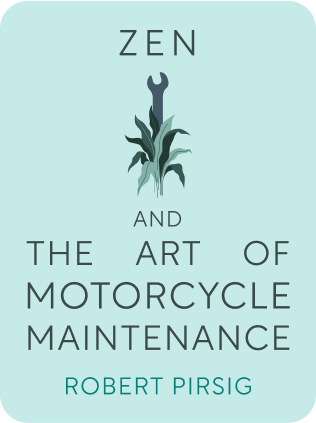

This article is an excerpt from the Shortform book guide to "Zen And The Art Of Motorcycle Maintenance" by Robert Pirsig. Shortform has the world's best summaries and analyses of books you should be reading.
Like this article? Sign up for a free trial here .
Who are the Zen and the Art of Motorcycle Maintenance characters? How do they each influence the stories and philsophies?
There are several important Zen and the Art of Motorcycle Maintenance characters. In addition to Pirsig and his son, there are other people they connect with along their journey.
Read more about the Zen and the Art of Motorcycle Maintenance characters.
5 Zen and the Art of Motorcycle Maintenance Characters
There are several important Zen and the Art of Motorcycle Maintenance characters in the book. In addition to the narrator and his son, there are also several Zen and the Art of Motorcycle Maintenance characters they meet on their journey.
Read more about the Zen and the Art of Motorcycle Maintenance characters.
Robert Pirsig
Shortform note: The first track of the book, told in the present tense, follows an unnamed narrator (whom Shortform, because of the numerous parallels between the narrator and the real-life Robert Pirsig, has chosen to call “Pirsig”)
When the book begins, Pirsig and Chris have just left Minneapolis on motorcycles. They are accompanied by John and Sylvia Sutherland, friends of Pirsig, who are riding with the Pirsigs as far as Bozeman, Montana. Whereas Pirsig is an editor of technical manuals, John is a drummer, and their differing attitudes toward motorcycle maintenance provide the impetus for Pirsig’s early Chautauquas on technology.
As the riders make their way west, the Pirsigs’ backstory is slowly revealed. The key plot points are as follows:
- Some years before the ride, Pirsig suffered a mental breakdown and was institutionalized. He was treated with electroshock therapy, which caused him to forget who he was before the treatment. Through occasional fragments of memory and his own research, he’s been able to get a sense of the person he was before. He calls this person Phaedrus.
Chris
The book opens in the height of summer with Pirsig on his motorcycle, his son, Chris, seated behind him. They’re riding from Minneapolis to Montana alongside Pirsig’s friends, John and Sylvia Sutherland; when we join the travelers, they’re on a two-lane road somewhere in western Minnesota. Pirsig catches sight of a red-winged blackbird taking flight and points it out enthusiastically to Chris, but Chris, who’s 11, isn’t very impressed. Pirsig theorizes that the reason he’s so taken with the surroundings is because they’re bound up with his memories, memories Chris doesn’t have.
Additional Zen and the Art of Motorcycle Maintenance Characters
Two more Zen and the Art of Motorcycle Maintenance characters are John and Sylvia Sutherland and the DeWeeses.
John and Sylvia Sutherland
John Sutherland is Pirsig’s prime example of a romantic thinker. Sutherland refuses to learn how to maintain his motorcycle because it’s “square”—it smacks of cold, procedural knowledge that runs counter to the “grooviness” and spontaneous creativity he prizes. Pirsig, meanwhile, a self-anointed classical thinker, relishes knowing how his motorcycle functions and being able to repair it if something goes wrong.
When a faucet begins dripping at the Sutherlands’ house, John makes a cursory stab at fixing it, then just lets it drip. On a day when Pirsig is over, Sylvia, who speaks softly, is trying to make herself heard over the dripping when her kids enter noisily. She blows up at the kids for interrupting her but doesn’t acknowledge that her anger was primed by the dripping.
The Sutherlands often talk about how there’s no escape from “it,” “it all,” “the whole organized bit,” and “the system.” Pirsig realizes that the Sutherlands are referring to a kind of dark force that gives rise to, and is epitomized by, technology. To the Sutherlands, this force is monstrous and unintelligible—inhuman.
Of course, the Sutherlands aren’t alone in resisting technology—at the time Zen and the Art of Motorcycle Maintenance was being written, an anti-technological movement, embodied by so-called “beatniks” and “hippies,” was well established. (Shortform note: Though Pirsig dubs the Sutherlands’ nemesis “technology,” it overlaps with counterculture enemies like “mass culture,” “materialism,” and “conformism.”)
The DeWeeses
The Sutherlands ask Pirsig how he met the family they’ll be staying with in Bozeman, the DeWeeses. Pirsig has to admit that he doesn’t remember. The DeWeeses are friends of Phaedrus’s friends—the husband, Bob, whom Pirsig refers to as DeWeese, is an abstract painter who teaches at the college in Bozeman—and Pirsig tells us that he hasn’t seen them since Phaedrus was erased.
Pirsig’s memories of Phaedrus’s relationship with DeWeese are fragmentary, but he knows that Phaedrus was fond of DeWeese. His fondness stemmed from the fact that DeWeese continuously surprised Phaedrus: When Phaedrus expected one reaction from DeWeese, DeWeese would often produce the exact opposite reaction.
DeWeese’s curious responses led Phaedrus to believe DeWeese possessed some deep knowledge that could help Phaedrus. And DeWeese, Phaedrus later discovered, felt a similar curiosity about him.

———End of Preview———
Like what you just read? Read the rest of the world's best book summary and analysis of Robert Pirsig's "Zen And The Art Of Motorcycle Maintenance" at Shortform .
Here's what you'll find in our full Zen And The Art Of Motorcycle Maintenance summary :
- How an unnamed narrator and his son are on a cross-country motorcycle journey
- Why technology can be creative
- How to focus on what's in front of you in order to get exactly what you need






